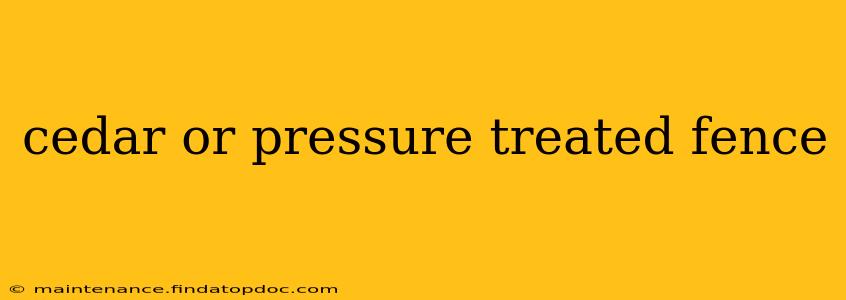Choosing the right fence material is a crucial decision for any homeowner. Two popular options often top the list: cedar and pressure-treated wood. Both offer durability and aesthetic appeal, but they differ significantly in their properties, longevity, and overall cost. This comprehensive guide will help you weigh the pros and cons of each to make an informed decision for your property.
What is Cedar Fencing?
Cedar, a naturally rot-resistant wood, is a premium choice for fencing. Its beautiful reddish-brown hue and inherent durability make it a popular option for those seeking a more aesthetically pleasing and naturally long-lasting fence. Different cedar varieties exist, with some offering greater resistance to rot and insects than others. Western Red Cedar is particularly well-regarded for its longevity.
Pros of Cedar Fencing:
- Natural Beauty: Cedar's rich color and attractive grain make it a visually appealing choice that complements many landscaping styles.
- Naturally Rot-Resistant: Cedar contains natural oils that provide inherent resistance to decay and insect infestation.
- Low Maintenance: Compared to pressure-treated wood, cedar requires less maintenance over its lifespan.
- Pleasant Aroma: Many find the subtle cedar scent enjoyable.
Cons of Cedar Fencing:
- Higher Cost: Cedar is significantly more expensive than pressure-treated pine or other softwoods.
- Susceptibility to Weathering: While rot-resistant, cedar can still fade and gray over time if not properly treated.
- Potential for Knots and Cracks: Like any natural wood, cedar can contain knots and cracks that can affect its strength and appearance.
What is Pressure-Treated Wood Fencing?
Pressure-treated wood, typically pine or fir, is treated with chemicals under high pressure to protect it from rot, decay, and insect damage. This process significantly extends its lifespan compared to untreated lumber. However, it's crucial to understand the type of treatment used, as different formulations have varying levels of toxicity and environmental impact.
Pros of Pressure-Treated Wood Fencing:
- Affordability: Pressure-treated lumber is considerably cheaper than cedar.
- Durability: The treatment process makes it highly resistant to rot, decay, and insects, offering a long lifespan.
- Wide Availability: Pressure-treated lumber is readily available at most lumberyards and home improvement stores.
- Strength: Generally, pressure-treated wood offers good strength and stability for fencing.
Cons of Pressure-Treated Wood Fencing:
- Chemical Treatment: The chemicals used in pressure treating can be toxic, raising environmental concerns. Look for lumber treated with less-toxic options if this is a priority.
- Less Aesthetically Pleasing: The appearance of pressure-treated wood is generally less attractive than cedar, often appearing more uniform and less visually interesting.
- Potential for Splinters: Pressure-treated wood can be more prone to splintering than cedar, requiring careful handling.
- Maintenance: While more durable than untreated wood, pressure-treated fences may still need occasional cleaning and repainting or staining to maintain their appearance and protect against weathering.
How Long Does Each Type of Fence Last?
The lifespan of both cedar and pressure-treated wood fences depends on factors like climate, maintenance, and the quality of the wood and installation. Generally:
- Cedar: A well-maintained cedar fence can last 20-30 years or even longer.
- Pressure-Treated Wood: A pressure-treated wood fence can last 15-20 years, depending on the type of treatment and environmental conditions.
Which Fence is Right for Me?
The best choice depends on your budget, aesthetic preferences, and priorities.
- Choose Cedar if: You prioritize aesthetics, natural beauty, and are willing to pay a premium for a longer-lasting, low-maintenance option with a naturally beautiful look.
- Choose Pressure-Treated Wood if: You're on a tighter budget and prioritize durability and longevity without the higher cost of cedar.
What are the Different Types of Pressure Treated Wood?
Different pressure-treated lumber uses different preservatives. Understanding the type of treatment used can help you make an informed decision, particularly concerning environmental impact and potential toxicity. Always inquire about the specific preservative used when purchasing pressure-treated lumber.
How Much Does Each Type of Fence Cost?
The cost of fencing varies widely based on location, labor costs, fence height, and the style of the fence. However, cedar fencing will generally cost significantly more than pressure-treated wood fencing per linear foot.
Is Pressure-Treated Wood Safe for Pets?
While the chemicals used in pressure-treated lumber are less toxic than in the past, it's still advisable to thoroughly clean and treat any splinters to minimize potential health risks to pets. Proper installation and regular maintenance can also reduce the risk of pets coming into contact with treated wood. If you have concerns, consult your veterinarian or research the specific type of preservative used in your lumber.
This guide provides a comprehensive overview of the key differences between cedar and pressure-treated wood fencing. By carefully considering your needs and budget, you can select the ideal fencing material to enhance your property's beauty and security for years to come.
